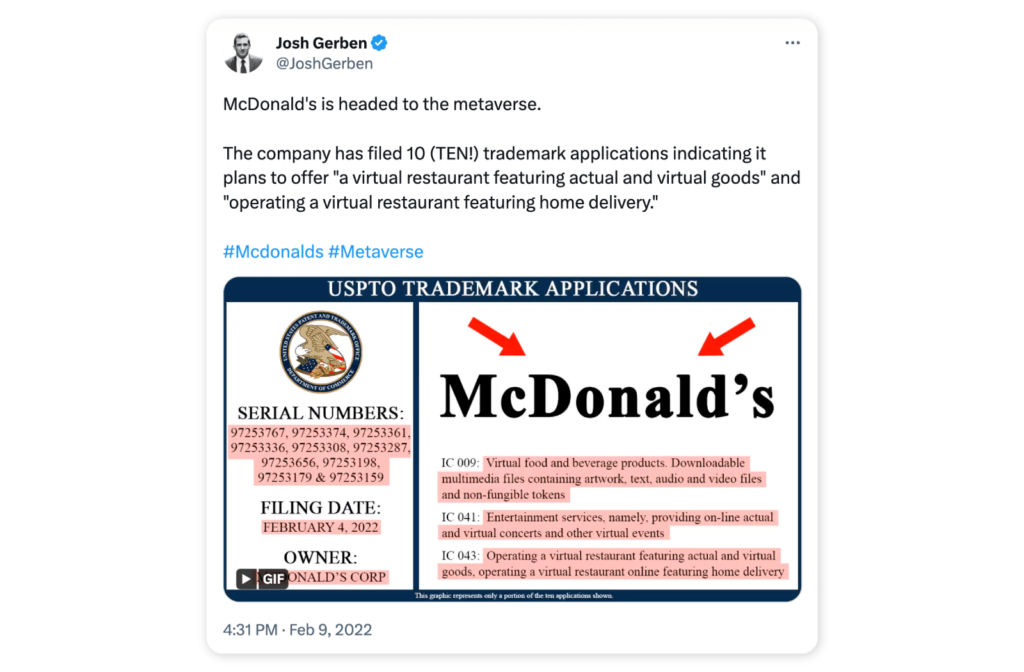Summarize this article via
It’s time to leave mundane marketing strategies at the door and enter a world of avatars, pixels, and virtual reality.
Once a distant dream, the launch of the Metaverse has made parallel universes a reality. The place where the physical and virtual worlds collide, the Metaverse provides a space where innovation is the currency and users have endless creative control. As we pass through the digital frontier, Metaverse marketing is leading the way. From personalized experiences to immersive shopping to multidimensional shopping, businesses have a lot to gain.
This guide dives deep into everything your business needs to know about Metaverse marketing, including challenges, best practices to follow, and examples of it in action.
First up, we explore the big questions like “What is the Metaverse?”, “Why is it the future of marketing?”, and “How does Metaverse marketing work?”.
Strap on your VR goggles, and let’s get started.
Understanding the metaverse
The metaverse is a virtual reality space that enables people to immerse themselves in a simulated digital environment and interact with each other. Think of it as a shared online world where you can play games, socialize, work, shop, and more. It’s not specific to a single platform or game but rather a series of interconnected virtual spaces, apps, and sites.
So, how does it work? Metaverse users create their own digital avatars and then move around a virtual world (much like they do in the real world). For instance, they can watch a movie in a virtual theater, give a presentation in a virtual meeting, or go on a coffee date at a virtual cafe. What’s more, users can design, buy, and sell digital objects, like clothing for their avatars.
With seemingly endless possibilities to interact with customers, promote products, and create personalized experiences, many are touting it as the future of marketing. While it may still be an emerging trend, businesses and leading innovators would do well to keep on top of the latest Metaverse news.
In a nutshell, the Metaverse blurs the lines between the physical and virtual world. In the process, we’ll see a shift from current life marketing to new life marketing.
Key characteristics of the Metaverse
Still a virtually (excuse the pun) unknown concept, we break down the standout features of the Metaverse so far.
Key characteristics of the Metaverse
Interconnectivity: It connects different virtual spaces, platforms, and apps to allow users to interact seamlessly with digital content.
Social: Users coexist in a shared virtual space, allowing them to interact with each other in real-time no matter the distance. They can communicate by text or voice, build communities, attend events, and collaborate on projects, making it a social space.
Participative: It encourages users to create and share their own user-generated content like digital objects and environments. This creates an inclusive and immersive experience.
Cross-platform compatibility: It doesn’t just exist on one platform or app. Users can participate using multiple technologies. There’s also potential for cross-industry integrations.
Immersive: The Metaverse incorporates haptic feedback, spatial audio, and other sensory elements to create a multidimensional experience for users.
Personalized user experiences: Users can completely customize their avatars and virtual spaces for a totally unique experience.
Take a look at the Metaverse commercial to see some of the real-world impact it’s expected to have.
8 reasons why Metaverse marketing is here to stay
We said earlier that Metaverse marketing is the future; now we’ll explain why. Here are eight compelling reasons why it’s here to stay.
Branding 2.0: Businesses can set up innovative branded events, virtual stores, and interactive experiences to truly represent their identity and resonate with users in a way that’s never been done before.
Unforgettable immersive events: The Metaverse allows organizations to create or sponsor virtual events that connect with their target audience and tell a story. Think of concerts, exhibitions, quests, or product launches that will captivate audiences and leave a lasting impression.
Enhanced customer experiences: Businesses can interact with customers in real-time via virtual events, social interactions, and immersive experiences. As such, they can gather insightful feedback to create more targeted marketing and tailored experiences.
New and improved advertising: Companies can place virtual ads in the Metaverse, including virtual billboards and interactive advertisements that encourage users to engage. Plus, the possibilities for product placement are huge. Businesses can showcase products in virtual environments, even modeling their latest products on virtual avatars.
A whole lot more reach: There are no geographical barriers in the Metaverse, meaning brands can connect with customers all over the globe. This makes it a great tool for businesses to gain visibility and attract a global audience.
The future of socializing: Social interaction is the lynchpin of the Metaverse. Businesses can leverage this by organizing events that create a sense of community. For instance, a beauty brand could host virtual beauty workshops and collaborative makeup sessions to encourage customers to interact with each other in real-time.
Alternate revenue streams: Businesses can use e-commerce integration to sell virtual or real-world products, generating sales and revenue. They can further boost revenue by exploring virtual real estate and in-app purchases.
Future-proofing: Whether you like it or not, the Metaverse is here to stay. And businesses that stay ahead of the curve can position themselves as thought leaders in their industries. This can help them stay relevant and maintain a competitive edge.
5 Metaverse marketing examples
Big-name brands have already jumped on the Metaverse bandwagon and seen huge success with their marketing efforts. Here are five of our favorites.
1. McDonald’s + Second Life virtual restaurants
Fast-food leader, McDonald’s dipped its toes in the Metaverse by creating virtual restaurants in the VR platform Second Life. The goal of the Metaverse marketing initiative was to increase brand reach and engage with its target audience in an interactive and innovative way.
Users can visit virtual McDonald’s restaurants, explore the 3D environment, and purchase virtual food and beverages.
McDonald’s is just one of many virtual restaurants users can visit on Second Life.
McDonald’s seems to be all aboard when it comes to the Metaverse, apparently applying for ten different patents.

These patents would enable the fast-food giant to deliver food online, offer entertainment, and sell non-fungible tokens (NFTs).
In the near future, it looks like users will be able to walk into a virtual McDonald’s, order food, and have it arrive at their door. No need to take off your VR headset or leave the house.
2. Red Bull + VRChat virtual racing competitions
Red Bull has become iconic not just for its energy drinks but its connection with extreme sports, too (it gives you wings, apparently). So, it makes sense that one of the brand’s first ventures into the VR arena is a virtual racing competition.
In typical adrenaline-junkie style, users can compete in virtual races on the Metaverse platform VR chat. The strategy was a success, engaging its target audience in an immersive and heart-fluttering VR experience.
3. Warner Bros + Fortnite virtual movie premieres
Movie premieres got a whole new look when Warner Bros decided to collaborate with Fortnite to put on a series of virtual film premieres. Hosted inside Fortnite’s virtual world, users could watch exclusive trailers and full-length movies, enjoying a shared cinematic experience from their own homes.
The initiative was a huge success, allowing Warner Bros to capitalize on Fortnite’s user base to reach a wide new audience.
4. Nike + Roblox virtual sneaker drops
Nike is one of the best-known sportswear brands on the planet and a thought leader in the industry. So, it’s hardly surprising that it has jumped on the Metaverse train. Partnering with multiple platforms, including Roblox, Nike creates limited-edition digital sneakers. Then, users can purchase them and show them off on their avatars.
Nike has also released its first NFT sneaker, called Our Force 1 (a play on the iconic Air Force 1 sneaker) on its new .Swoosh platform. For the price of $19.82, users can buy one of two digital boxes. Each box contains different sneaker designs, including a design created by four fans.
Each NFT comes with a 3D file so users can express themselves in fun and creative new ways. Nike also plans to expand this new strategy, giving customers access to exclusive physical products and VR experiences.
5. Coca-Cola’s brand experiences
Coca-Cola is always ahead of the curve. And the Metaverse is no different. The brand has built a series of virtual rand experiences, including virtual concerts, pop-up stores, and interactive experiences. Users can also customize avatars and participate in virtual taste testing.
A standout Metaverse marketing moment was the “One Coke Away From Each Other” campaign. Hosted on the “Real Magic” platform, it’s an immersive movie that features three famous gamers. In addition, the campaign encompasses a series of social and digital interactions, including a code hunt, interactive live streaming service, and prize giveaways.
To appeal to a tech-savvy audience, Coco-Cola partnered with Twitch so that gaming creators can unlock more codes during live streams.
5 best practices for Metaverse marketing
As a relatively new and untested marketing approach, it can be tricky for businesses to navigate. Avoiding common pitfalls and focusing on the right aspects can save your company significant time and resources.
To guide you, we’ve rounded up five best practices for Metaverse marketing that you need to know.
Tip 1: Focus on delivering memorable experiences
The best way to make your Metaverse marketing campaign a hit is to create authentic experiences that your users won’t forget in a hurry. Think outside of the box to build something that truly aligns with your brand and resonates with your ideal audience.
For instance, travel agencies can create virtual destination experiences that allow users to explore exotic locations, experience the local culture, and picture what their next vacation could look like.
The Walt Disney Company is already on its way to creating a real-world theme park with a parallel virtual reality experience.
Tip 2: Explore cross-metaverse collaboration
Don’t just focus on one platform. Instead, collaborate with multiple Metaverse platforms to expand your brand’s reach and connect with different user bases. Different platforms focus on different things, allowing businesses to broaden their market presence. What’s more, it creates opportunities to build shared virtual spaces and environments that span several platforms.
Tip 3: Encourage user-generated content (UGC)
The best way to generate user content (and get your audience participating) is to design campaigns that encourage it. This could mean running campaigns that ask users to share their virtual makeup looks using your products or hosting contests with incentives for users to enter a submission. All of this builds an engaged and active audience that will quickly become brand advocates.
Take the NBA. It partnered with the video game franchise NBA 2K to create a digital basketball tournament. Users had control over their favorite NBA teams and could even create their own players to compete in virtual matches. The result was an immersive experience that drove NBA fans to generate their own content.
The NBA has also created a VR experience for courtside viewing.
Tip 4: Integrate Metaverse experiences with real-world ones
The most exciting thing about the Metaverse is how seamlessly you can blend real-world interactions with virtual experiences. So, businesses should make the most of this by connecting real-world events and products to Metaverse spaces. Not only does it create a cohesive brand presence, but it aligns virtual and physical customer experiences.
Gucci is a great example. In 2021, the luxury fashion giant used virtual reality (VR) to host an immersive fashion show on Roblox that allowed users to attend as their avatars. During the event, users could explore a replica of the actual Gucci Garden, interact with 3D virtual products, and experience a front-row view. It was a huge success, generating a media frenzy.
5. Utilize data to tailor marketing efforts
The best way to gain deep insight into how your content is performing on the Metaverse is through data. Carefully analyze key metrics, including user behavior, preferences, and engagement. This will give you the information you need to customize your brand’s messaging, offers, and content.
For instance, music streaming platforms can leverage Metaverse data to create tailored concerts based on users’ preferences.
Speaking of virtual concerts, Roblox hosted one by world-famous artist The Weeknd. As one of the first of its kind, millions of fans attended the show, creating a memorable experience.
Major metaverse marketing challenges
Despite having significant potential to disrupt the business world, Metaverse marketing is not without its challenges. Privacy concerns, a lack of standardization, and a general distrust of virtual reality are just some of the barriers this new form of marketing is up against.
In this section, we break down six of the major roadblocks and possible solutions.
Challenge 1: Lack of interoperability
Let’s say you’re a leading retail brand, and you want to establish a virtual store. A lack of standardized protocols and interoperability between various Metaverse platforms could make it challenging for you to build a consistent presence. As a result, managing these spaces could be costly, complex, and time-consuming.
Possible solution:
Partnering with Metaverse providers to create standard protocols for the creation and management of virtual spaces. What’s more, businesses can use blockchain to build a more interoperable and flexible system.
Challenge 2: Limited user adoption
When we compare user adoption with traditional online platforms, it remains relatively low. This can lead to fragmented audiences and limit your brand’s ability to reach a larger customer base. The risk for many businesses is investing resources in a Metaverse marketing campaign and only reaching a small user base. If the campaign isn’t impactful, marketing teams could face losses.
Possible solution:
Researching the market to identify the most widely used Metaverse platforms is a good place to start. That way, businesses can focus their marketing efforts where there is already a substantial audience. Additionally, building high-quality experiences will attract a wider audience to Metaverse platforms and increase user adoption.
Challenge 3: Privacy and security issues
Privacy is a big concern for many people, especially considering that Metaverse environments tend to collect and store user data. Let’s say that a major Metaverse platform suffers a data breach; any businesses associated with the platform could be held responsible in the eyes of the public. This could lead to damage to their reputation and a loss of customers.
Possible solution:
Businesses need to implement stringent security measures to safeguard user data. For instance, using strict encryption and authentication protocols, conducting regular security checks, and complying with data protection regulations.
Challenge 4: Managing and moderating content
Businesses need robust content management systems to effectively filter, manage, and moderate user-generated content. A failure to do so can result in unsafe or inappropriate environments popping up on the Metaverse, which can tarnish a brand’s reputation, create negative user experiences, and create legal issues. Let’s say a Metaverse platform doesn’t moderate offensive content thoroughly. Businesses using that Metaverse could face backlash even though it’s not their fault.
Possible solution:
The only way around this is to create clear community guidelines and use a combination of human moderation and automated tools to filter any inappropriate content. Businesses should take a strong stance on this from the get-go so users are clear on what is and isn’t appropriate in that space.
Challenge 5: Measuring the impact of marketing efforts
Even the best marketing campaign needs data to prove its success, optimize strategies, and measure ROI. That’s why traditional digital marketing channels boast such robust analytics and measurement tools. In comparison, Metaverse marketing analytics are pretty basic. This makes it difficult to track KPIs, such as sales and user engagement, accurately.
Possible solution:
First and foremost, businesses need to define clear KPIs to measure the impact of their Metaverse marketing campaign. Then, they should consider using a robust digital analytics tool like Sociality.io combined with specialized Metaverse analytics software. That will give a comprehensive overview of how the campaign is performing.
Challenge 6: Integrating with current strategies
Metaverse marketing must integrate and align with existing channels. Otherwise, your brand’s marketing efforts will be disjointed and confusing. However, this takes precise planning, communication, and coordination across multiple teams. For example, you may need to tweak your current social media strategy to get the desired results.
Possible solution:
Having a clear plan in place and implementing cross-functional teams can help tackle this issue. These cross-functional teams can work together to align various marketing channels and adapt strategies to fit the Metaverse.
A surprising future challenge …
As the Metaverse continues to evolve, we could soon face another challenge: a collective identity crisis.
Metaverse users have free reign to create and customize avatars. While this is great for users looking to express their creativity, it could result in users having multiple avatars across different platforms. The issue arises when the lines between real and digital personas become so blurred that users feel confused and distrustful toward each other.
This also poses a significant challenge for businesses, making it difficult to foster real connections with their target audiences.
Possible solution:
Luckily, Metaverse experts are already working on identity verification systems that will securely link users’ real identities to their virtual personas. These systems include biometrics, blockchain, and robust encryption in a bid to protect user data while creating a seamless verification process.
Businesses will benefit greatly from these systems, allowing them to engage with their target audience and build trust in the Metaverse. Plus, it will reduce the risk of fraudulent transactions or interactions.
A final word on Metaverse marketing
Metaverse marketing is an exciting and slightly daunting prospect. But, businesses that embrace it early can position themselves as innovators and thought leaders in their industries. At the same time, they avoid being left behind or losing touch with their audiences.
With endless opportunities to promote your brand’s products, connect with audiences, and target marketing efforts, now’s the time to dip your feet in the waters of Metaverse marketing. With that said, Metaverse marketing is not without its challenges. Building a consistent brand identity across multiple Metaverse platforms can take time and effort. At the same time, reaching the right audience and measuring the impact of your efforts requires work.
Investing in a robust social media management tool like Sociality.io can help your business align its marketing strategies with the Metaverse. From analyzing user data to benchmarking competitors, it takes the guesswork out of managing your brand’s socials.
So, why not grab a free trial today!




